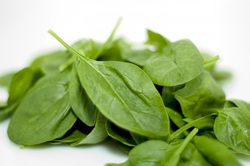
Spinach and other green leafy vegetables provide more nutrients than any other vegetables in the world. Spinach is packed with vitamins; it stores high levels of vitamin K and vitamin A. Vitamin K is crucially important for bone building. Vitamin K triggers a compound called osteocalcin which produces calcium molecules inside the bone. One cup of fresh spinach gives you 200 percent of the daily value of vitamin K which makes spinach a great alternative to dairy for people.
Vitamin A is important for reducing the amount of free-radicals in the body as well as preventing cholesterol from oxidation.
Spinach contains several important phytochemicals, including lutein, which helps prevent age-related macular degeneration. It also has lipoic acid, which helps antioxidant vitamins C and E regenerate. The minerals in spinach are highly alkaline, making it helpful in regulating the body pH. Also the high alkalinity properties in spinach help people who suffer from inflammatory ailments, like osteoarthritis and rheumatoid arthritis.
Spinach is an excellent source of folate. Folate contributes to the growth and health of your cells. Spinach also contains magnesium which helps regulate blood pressure and prevent heart disease.
Cooked spinach is also an excellent source of iron, which is one of the primary components in hemoglobin which makes spinach a great blood builder. It reactivates the red blood cells and supplies fresh oxygen to the body. High levels of iron in spinach play an important role in energy production and metabolism. Raw spinach is a good source of vitamin C which is a powerful antioxidant. However, if you overcook spinach, you will lose most of vitamin C.
Spinach is packed with flavonoids which act as antioxidants, protecting the body from free radicals. Researchers have found at least 13 different flavonoid compounds that act as anti-cancer substances. The various nutrients offer much in the way of disease protection. Current research suggests that are 13 different flavonoid compounds in spinach that not only serve as antioxidants but may also reduce the risk of cancer.
How to select
Look for crisp, fresh and green spinach leaves and avoid dry, yellow leaves. Discard any spinach with blemishes. Choose spinach with thin stems since thick stems indicate the spinach has been overgrown.
How to store
Place spinach in the refrigerator in a plastic bag. Since spinach is best eaten fresh, consume within 2 to 3 days of purchase.
How to prepare
Rinse spinach under cold water in a colander and remove excess moisture before serving or cooking.
Vitamin A is important for reducing the amount of free-radicals in the body as well as preventing cholesterol from oxidation.
Spinach contains several important phytochemicals, including lutein, which helps prevent age-related macular degeneration. It also has lipoic acid, which helps antioxidant vitamins C and E regenerate. The minerals in spinach are highly alkaline, making it helpful in regulating the body pH. Also the high alkalinity properties in spinach help people who suffer from inflammatory ailments, like osteoarthritis and rheumatoid arthritis.
Spinach is an excellent source of folate. Folate contributes to the growth and health of your cells. Spinach also contains magnesium which helps regulate blood pressure and prevent heart disease.
Cooked spinach is also an excellent source of iron, which is one of the primary components in hemoglobin which makes spinach a great blood builder. It reactivates the red blood cells and supplies fresh oxygen to the body. High levels of iron in spinach play an important role in energy production and metabolism. Raw spinach is a good source of vitamin C which is a powerful antioxidant. However, if you overcook spinach, you will lose most of vitamin C.
Spinach is packed with flavonoids which act as antioxidants, protecting the body from free radicals. Researchers have found at least 13 different flavonoid compounds that act as anti-cancer substances. The various nutrients offer much in the way of disease protection. Current research suggests that are 13 different flavonoid compounds in spinach that not only serve as antioxidants but may also reduce the risk of cancer.
How to select
Look for crisp, fresh and green spinach leaves and avoid dry, yellow leaves. Discard any spinach with blemishes. Choose spinach with thin stems since thick stems indicate the spinach has been overgrown.
How to store
Place spinach in the refrigerator in a plastic bag. Since spinach is best eaten fresh, consume within 2 to 3 days of purchase.
How to prepare
Rinse spinach under cold water in a colander and remove excess moisture before serving or cooking.
 RSS Feed
RSS Feed